
Water emergencies can strike when you least expect them. Whether it’s a burst pipe, an overflowing toilet, or a persistent leak, quick action can prevent costly damage. This guide will walk you through the steps to shut off your main valve in seconds, minimizing damage and stress.
The Importance of Acting Fast In A Water Emergency
Water damage doesn’t wait. A minor leak can escalate into thousands of dollars in repair costs in just an hour. This is why every homeowner should know how to locate and shut off their water supply. It’s not just about saving money—it’s about protecting your home and peace of mind.
Step 1: Identify the Source
The first step in a water emergency is locating the source of the leak. If the issue is localized, such as a dripping faucet or a running toilet, the problem may be solved by turning off the fixture’s water supply. However, for more significant issues—like a burst pipe or flooding—you’ll need to shut off the main water supply immediately.
Step 2: Turning Off Local Shut-Off Valves
Most fixtures in your home, like sinks, toilets, and appliances, have individual shut-off valves. These are typically located close to the affected area:
- Under the Sink: Look for the valve beneath the sink and turn it clockwise to shut off the water.
- Behind the Toilet: Find the valve near the wall behind the toilet and turn it clockwise.
- Appliances: Shut-off valves for appliances like washing machines or dishwashers are often located behind or near the appliance.
These localized solutions are great for small leaks, allowing you to keep the rest of your home’s water supply functional while addressing the issue.
Step 3: Shutting Off the Main Water Supply
For major water emergencies, you need to shut off your home’s main water supply. Here’s how:
- Locate the Main Shut-Off Valve: Typically found in your basement, utility room, or near your water meter.
- Turn the Valve Off: Most valves can be turned clockwise to stop flow. If the valve is stiff or hard to turn, you might need a wrench.
Pro Tip: Test your main shut-off valve annually to ensure it’s functional and consider labeling it for easy identification in an emergency.
Step 4: Assess the Situation and Call a Professional
Once the water is off, take a moment to evaluate the damage. If it’s safe, you can start cleaning up minor spills or moving belongings out of harm’s way. For significant damage or if you’re unsure about the next steps, it’s best to call a professional plumber. They can address the issue and restore your water supply safely.
Why Preparation Matters
The key to managing a water emergency is preparation. Knowing where your shut-off valves are and how to use them can make a world of difference. It’s also worth considering these additional precautions:
- Label Shut-Off Valves: Mark all valves for quick access.
- Conduct Routine Checks: Ensure your valves are functional by testing them at least once a year.
- Educate Your Family: Make sure everyone in your household knows where the main shut-off valve is located and how to use it.
Visualizing the Impact
Imagine this scenario: A small leak under your sink goes unnoticed for hours. The result? Water pooling on the floor, damage to cabinetry, and potential mold growth. Contrast this with a prepared homeowner who knows where the shut-off valve is. In just seconds, the water is stopped, and the damage is minimized. The difference is clear.
Final Thoughts
Emergencies are stressful, but they don’t have to be catastrophic. By learning to shut off your main valve, you’re proactively protecting your home. Remember, the faster you act, the less damage you’ll face.
If you found this guide helpful, share it with your fellow homeowners. Preparation and knowledge are the first lines of defense against water emergencies. For more home maintenance tips, stay tuned and prioritize your peace of mind!


Ruud R962V Endeavor Line Achiever Plus Series Gas Furnace: The Ideal Choice for Salt Lake City Homes


